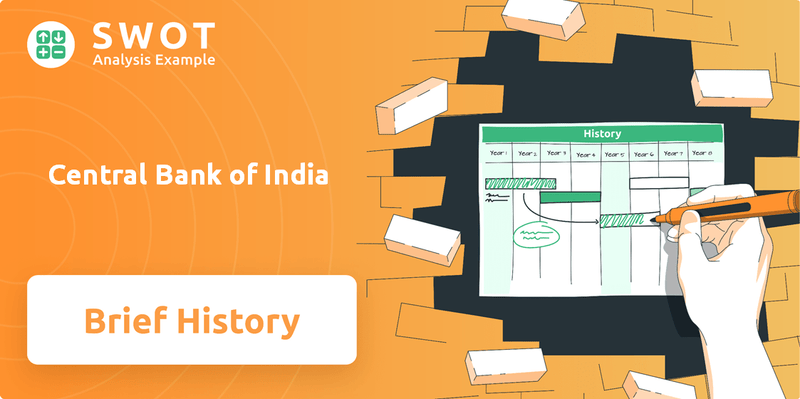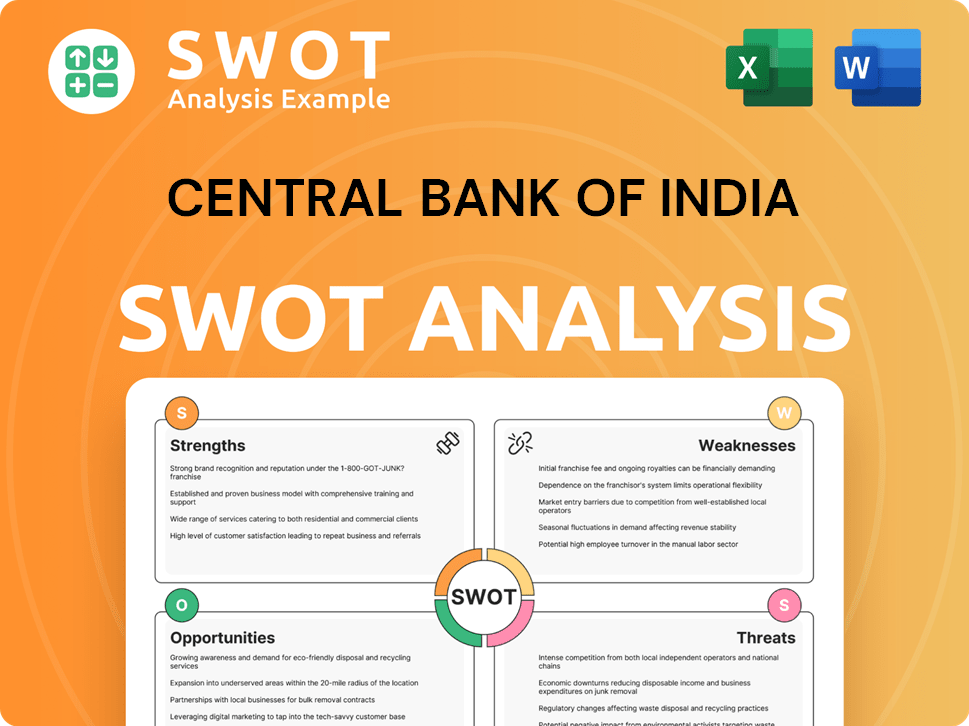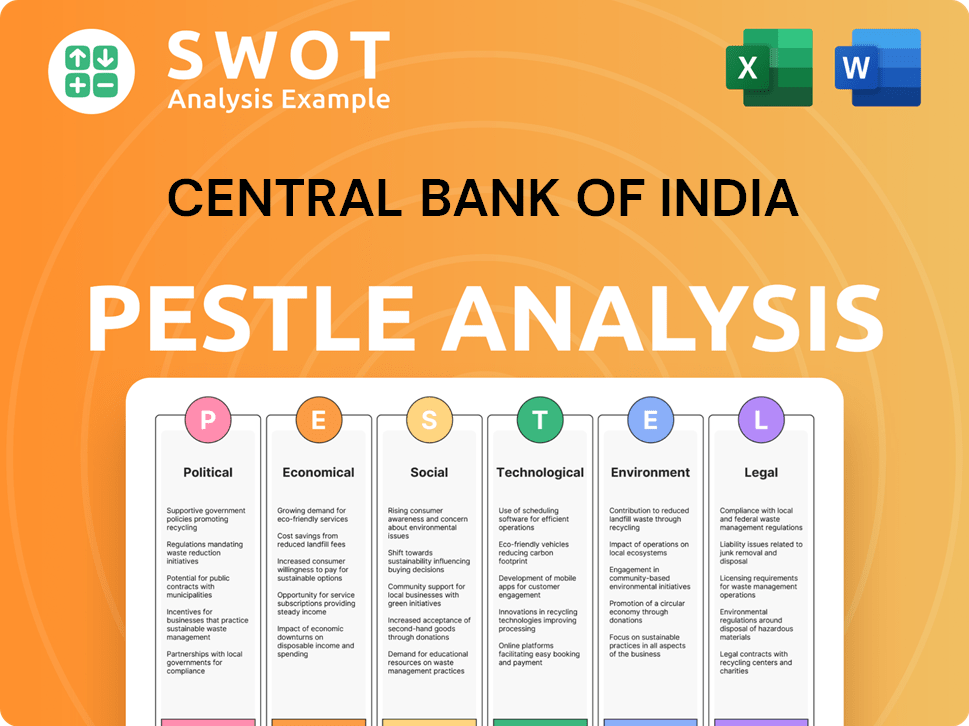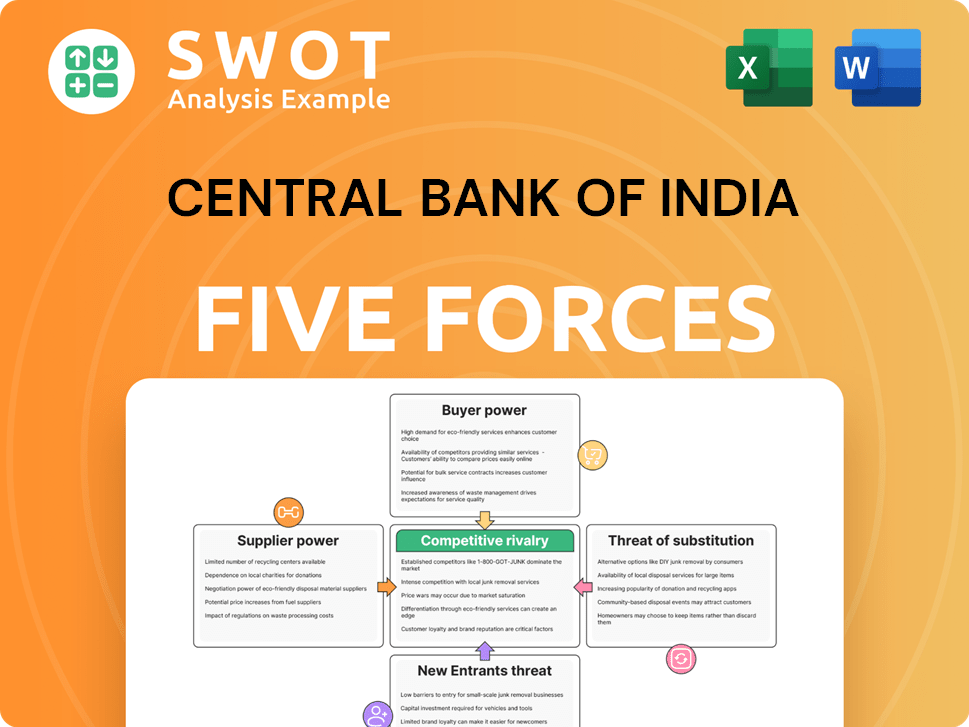Central Bank of India Bundle
How has Central Bank of India Shaped Indian Banking History?
Journey back in time to uncover the Central Bank of India SWOT Analysis and its pivotal role in shaping India's financial landscape. Established in 1911, this pioneering institution, driven by a vision of self-reliance, became the first Indian bank wholly owned and managed by Indians. From its inception, it aimed to empower the Indian populace and fuel the nation's economic growth.

This deep dive into CBI history reveals its evolution from a 'Swadeshi Bank' to a major player in the Indian economy. Understanding the CBI company's early years, its response to economic policies, and its current financial performance sheds light on its enduring impact. Learn about the RBI role in CBI and how this commercial bank has contributed to India's industrialization and modernization, making it a fascinating case study in Indian banking history.
What is the Central Bank of India Founding Story?
The Central Bank of India (CBI), a pivotal institution in Indian banking history, has a rich founding story. Established on December 21, 1911, in Mumbai, it emerged as a beacon of indigenous financial empowerment. The bank's inception was driven by a strong nationalist sentiment and a desire to create a financial institution controlled by Indians, for Indians.
Sir Sorabji Pochkhanawala spearheaded the CBI establishment with the vision of an entirely Indian-owned and operated commercial bank. Sir Pherozeshah Mehta, a prominent figure, became the first chairman, underscoring the bank's 'Swadeshi' identity. This initiative was a direct response to the dominance of foreign banks in the Indian financial landscape, aiming to serve the interests of the Indian people and foster the growth of the Indian economy. The Revenue Streams & Business Model of Central Bank of India provides further insights into the bank's operations.
The bank's initial business model revolved around traditional commercial banking activities, including accepting deposits, lending money, and providing general banking services. Pochkhanawala's declaration, that the Central Bank of India was 'the property of the nation and the country's asset,' reflected his deep conviction. The initial funding likely came from Indian investors, aligning with the bank's ethos of being 'wholly owned and managed by Indians.' This establishment was a critical step towards self-reliance and indigenous control over key economic sectors.
Here are the key aspects of the founding of the CBI company:
- Founding Date: December 21, 1911.
- Founder: Sir Sorabji Pochkhanawala.
- First Chairman: Sir Pherozeshah Mehta.
- Primary Goal: To establish a commercial bank owned and operated by Indians.
- Initial Focus: Traditional commercial banking activities.
Central Bank of India SWOT Analysis
- Complete SWOT Breakdown
- Fully Customizable
- Editable in Excel & Word
- Professional Formatting
- Investor-Ready Format

What Drove the Early Growth of Central Bank of India?
The early years of the Central Bank of India (CBI) were marked by significant growth and innovative initiatives. The Competitors Landscape of Central Bank of India showcases its proactive approach to expansion. This period saw the establishment of new branches and the introduction of customer-focused services, laying the foundation for its future prominence in Indian banking history.
By 1918, Central Bank of India had already expanded its presence with a branch in Hyderabad. Further expansion included a branch in Secunderabad in 1925. This early expansion was crucial in establishing its footprint across different regions.
A key move was the acquisition of the Tata Industrial Bank in 1923. This strategic acquisition strengthened its market position. The acquisition also included the Tata bank's Madras branch, which became part of Central Bank of India.
The bank introduced several pioneering initiatives. These included the Home Savings Safe Deposit Scheme in 1921, an Exclusive Ladies Department in 1924, and Safe Deposit Locker facilities in 1926. These services highlighted its customer-centric approach.
Central Bank of India played a role in the Central Exchange Bank of India in London in 1936. The bank also had operations in Burma (now Myanmar) before World War II. These operations focused on business and money transmission between Burma and India.
Central Bank of India PESTLE Analysis
- Covers All 6 PESTLE Categories
- No Research Needed – Save Hours of Work
- Built by Experts, Trusted by Consultants
- Instant Download, Ready to Use
- 100% Editable, Fully Customizable

What are the key Milestones in Central Bank of India history?
The CBI history is marked by several significant milestones, reflecting its growth and adaptation within the Indian banking landscape. These milestones showcase the bank's evolution and its response to the changing financial environment.
| Year | Milestone |
|---|---|
| 1980 | Central Bank of India was among the first banks in India to introduce credit cards in collaboration with Visa. |
| 2025 | On its 108th Foundation Day, the bank launched 'MEDHA,' embracing robotic banking to integrate advanced technology into its operations. |
| Ongoing | The bank has been instrumental in promoting rural entrepreneurship through initiatives like the Rural Development and Self Employment Training Institute (Rudseti) and establishing Financial Literacy and Credit Counseling Centers. |
Central Bank of India has consistently pursued innovations to enhance its services and operational efficiency. These innovations have helped the bank stay competitive and meet the evolving needs of its customers.
CBI history includes early adoption of technology, such as the introduction of credit cards in 1980, which was a significant step in modernizing banking services. The launch of 'MEDHA' in 2025, a robotic banking initiative, further demonstrates the bank's commitment to technological advancement.
The bank has focused on rural development through the Rural Development and Self Employment Training Institute (Rudseti). This initiative supports entrepreneurship and financial literacy in rural areas, contributing to broader economic development.
Despite its achievements, Central Bank of India has faced several challenges throughout its history. These challenges have tested the bank's resilience and required strategic adjustments to maintain its position in the market.
In 1969, Central Bank of India, along with 13 other major commercial banks, was nationalized, transforming it into a state-owned entity. This change significantly altered the bank's operational framework and strategic direction.
The bank has been subject to the RBI's Prompt Corrective Action (PCA) framework, which imposed restrictions on lending, dividend payments, and expenses. This indicates periods of financial stress and the need for stringent oversight.
Recently, Central Bank of India's stock has traded near a 52-week low, underperforming its sector, reflecting bearish market sentiment and ongoing challenges. This has prompted strategic moves to diversify revenue streams.
In June 2025, the bank acquired a 24.91% equity stake in Future Generali India Insurance Company Limited for up to ₹451 crore. This move, approved by regulatory bodies, is a strategic step to diversify into the insurance sector.
Central Bank of India Business Model Canvas
- Complete 9-Block Business Model Canvas
- Effortlessly Communicate Your Business Strategy
- Investor-Ready BMC Format
- 100% Editable and Customizable
- Clear and Structured Layout

What is the Timeline of Key Events for Central Bank of India?
The Growth Strategy of Central Bank of India has been shaped by pivotal moments, from its inception as the first Indian bank wholly owned by Indians to its recent strategic acquisitions. The journey of this financial institution reflects the evolution of Indian banking, marked by nationalization, technological advancements, and strategic expansions. The following timeline highlights key milestones in the history of Central Bank of India (CBI), illustrating its adaptability and growth over the years.
| Year | Key Event |
|---|---|
| 1911 | Established on December 21 by Sir Sorabji Pochkhanawala in Mumbai, marking the beginning of CBI. |
| 1918 | Opened its first branch in Hyderabad, expanding its reach. |
| 1921 | Introduced the Home Savings Safe Deposit Scheme, promoting savings. |
| 1923 | Acquired Tata Industrial Bank, broadening its financial services. |
| 1924 | Launched an Exclusive Ladies Department, catering to a specific market segment. |
| 1925 | Established a branch in Secunderabad, further extending its geographical presence. |
| 1926 | Introduced Safe Deposit Locker facilities, enhancing customer services. |
| 1936 | Instrumental in the creation of the Central Exchange Bank of India in London, expanding internationally. |
| 1938 | Central Exchange Bank of India acquired by Barclays Bank, reflecting shifts in the banking landscape. |
| 1969 | Nationalized by the Indian Government, becoming part of the public sector. |
| 1980 | One of the first banks in India to issue credit cards in collaboration with Visa, embracing new technologies. |
| 2009 | One of twelve public sector banks in India to be recapitalized, reflecting government support. |
| 2019 | Launched 'MEDHA,' a robot, as its first step towards robotic banking, embracing digital innovation. |
| 2022 | RBI's Prompt Corrective Action (PCA) framework was applied to the bank, reflecting regulatory oversight. |
| 2024 (August 20) | Received Letter of Intent to acquire a stake in Future Generali India Life Insurance Company. |
| 2024 (October 15) | Received CCI's nod to acquire stakes in Future Generali India Insurance and Future Generali India Life Insurance. |
| 2025 (March 31) | Total business reached ₹7,05,196 crore, a 10.75% YoY growth; Gross advances grew by 16.20% to ₹2,92,531 crore; Net Profit for Q4 FY25 increased by 28.13% to ₹1,034 crore. |
| 2025 (June 4) | Completed the acquisition of a 24.91% equity stake in Future Generali India Insurance Company Limited for up to ₹451 crore. |
CBI is prioritizing quality credit expansion and enhanced deposit focus to drive sustainable growth. Digital innovation and improved asset quality are key pillars of its strategy. Strategic branch expansion is planned to tap into the potential of various locations, increasing market presence.
The acquisition of a significant stake in Future Generali India Insurance Company is a pivotal move. This strategic expansion into the insurance sector aims to diversify revenue streams and enhance financial stability. This diversification is expected to boost overall profitability.
The Indian banking sector is expected to remain robust, with non-performing loans (NPLs) projected to stay steady at 2-3%. The Indian economy is forecast to grow at an average of 6.7% annually over the next decade. This positive economic environment supports CBI's future growth prospects.
CBI’s future will likely emphasize digital transformation and customer-centric services. Strategic partnerships and technological advancements will be key. The bank aims to maintain its founding vision of serving the nation's financial needs while adapting to the changing landscape.
Central Bank of India Porter's Five Forces Analysis
- Covers All 5 Competitive Forces in Detail
- Structured for Consultants, Students, and Founders
- 100% Editable in Microsoft Word & Excel
- Instant Digital Download – Use Immediately
- Compatible with Mac & PC – Fully Unlocked

Related Blogs
- What is Competitive Landscape of Central Bank of India Company?
- What is Growth Strategy and Future Prospects of Central Bank of India Company?
- How Does Central Bank of India Company Work?
- What is Sales and Marketing Strategy of Central Bank of India Company?
- What is Brief History of Central Bank of India Company?
- Who Owns Central Bank of India Company?
- What is Customer Demographics and Target Market of Central Bank of India Company?
Disclaimer
All information, articles, and product details provided on this website are for general informational and educational purposes only. We do not claim any ownership over, nor do we intend to infringe upon, any trademarks, copyrights, logos, brand names, or other intellectual property mentioned or depicted on this site. Such intellectual property remains the property of its respective owners, and any references here are made solely for identification or informational purposes, without implying any affiliation, endorsement, or partnership.
We make no representations or warranties, express or implied, regarding the accuracy, completeness, or suitability of any content or products presented. Nothing on this website should be construed as legal, tax, investment, financial, medical, or other professional advice. In addition, no part of this site—including articles or product references—constitutes a solicitation, recommendation, endorsement, advertisement, or offer to buy or sell any securities, franchises, or other financial instruments, particularly in jurisdictions where such activity would be unlawful.
All content is of a general nature and may not address the specific circumstances of any individual or entity. It is not a substitute for professional advice or services. Any actions you take based on the information provided here are strictly at your own risk. You accept full responsibility for any decisions or outcomes arising from your use of this website and agree to release us from any liability in connection with your use of, or reliance upon, the content or products found herein.